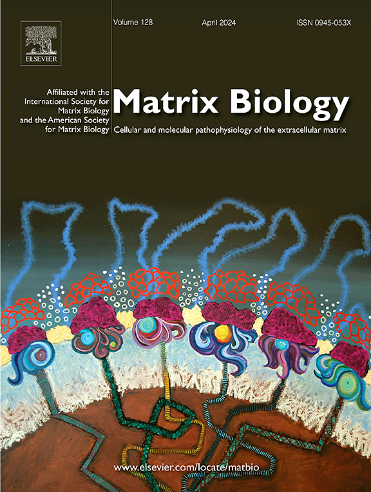Impact of vascular Ehlers-Danlos Syndrome-associated Gly substitutions on structure, function, and mechanics using bacterial collagen
IF 4.8
1区 生物学
Q1 BIOCHEMISTRY & MOLECULAR BIOLOGY
引用次数: 0
Abstract
Vascular Ehlers-Danlos syndrome (vEDS) arises from mutations in collagen-III, a major structural component of the extracellular matrix (ECM) in vascularized tissues, including blood vessels. Fibrillar collagens form a triple-helix that is characterized by a canonical (Gly-X-Y)n sequence. The substitution of another amino acid for Gly within this conserved repeating sequence is associated with several hereditary connective tissue disorders, including vEDS. The clinical severity of vEDS depends on the identity of the substituted amino acid and its location. In this study, we engineered recombinant bacterial collagen-like proteins (CLPs) with previously reported Gly→X (X=Ser or Arg) vEDS substitutions within the integrin-binding site. Employing a combination of biophysical techniques, enzymatic digestion assays, integrin binding affinity assays, and computational modeling, we assessed the impact of Gly→X substitutions on structure, stability, function, and mechanical properties. While constructs with Ser or Arg substitutions maintained a triple-helix structure, Arg substitution significantly reduced global thermal stability, heightened susceptibility to trypsin digestion, and altered integrin α2-inserted (α2I) domain binding. Molecular dynamics (MD) simulations also demonstrated distinct effects of different Gly substitutions on the triple-helix structure - Arg substitutions induced notable bulging at the substitution site and disrupted interchain hydrogen bonds compared to Ser substitutions. Additionally, steered MD simulations revealed that Arg substitution led to a significant decrease in the Young's modulus of the triple-helix. Bacterial CLPs have proved to be a powerful model for studying the underlying mechanisms of vEDS-causing mutations in collagen-III. Serine and arginine substitutions differentially perturb cell-matrix interactions and ECM in a manner consistent with clinical vEDS severity.

血管ehers - danlos综合征相关Gly置换对细菌胶原蛋白结构、功能和力学的影响。
血管性ehers - danlos综合征(vEDS)由胶原- iii突变引起,胶原- iii是血管化组织(包括血管)中细胞外基质(ECM)的主要结构成分。纤维状胶原形成一个三螺旋结构,其特征是典型的(Gly-X-Y)n序列。在这个保守的重复序列中,另一个氨基酸取代Gly与几种遗传性结缔组织疾病有关,包括vEDS。vEDS的临床严重程度取决于取代氨基酸的身份及其位置。在这项研究中,我们利用先前报道的整合素结合位点的Gly→X (X=Ser或Arg) vEDS取代,设计了重组细菌胶原样蛋白(CLPs)。采用生物物理技术、酶消化测定、整合素结合亲和力测定和计算建模相结合的方法,我们评估了Gly→X取代对结构、稳定性、功能和机械性能的影响。虽然以Ser或Arg取代的构建体保持了三螺旋结构,但Arg取代显著降低了整体热稳定性,提高了对胰蛋白酶消化的敏感性,并改变了整合素α2插入(α2I)结构域的结合。分子动力学(MD)模拟也证明了不同的Gly取代对三螺旋结构的不同影响——与Ser取代相比,Arg取代会导致取代位点明显的膨胀和链间氢键的破坏。此外,定向MD模拟显示,Arg取代导致三螺旋的杨氏模量显著降低。细菌CLPs已被证明是研究veds引起胶原- iii突变的潜在机制的强大模型。丝氨酸和精氨酸替代对细胞-基质相互作用和ECM的不同干扰与临床vEDS严重程度一致。
本文章由计算机程序翻译,如有差异,请以英文原文为准。
求助全文
约1分钟内获得全文
求助全文
来源期刊

Matrix Biology
生物-生化与分子生物学
CiteScore
11.40
自引率
4.30%
发文量
77
审稿时长
45 days
期刊介绍:
Matrix Biology (established in 1980 as Collagen and Related Research) is a cutting-edge journal that is devoted to publishing the latest results in matrix biology research. We welcome articles that reside at the nexus of understanding the cellular and molecular pathophysiology of the extracellular matrix. Matrix Biology focusses on solving elusive questions, opening new avenues of thought and discovery, and challenging longstanding biological paradigms.
 求助内容:
求助内容: 应助结果提醒方式:
应助结果提醒方式:


